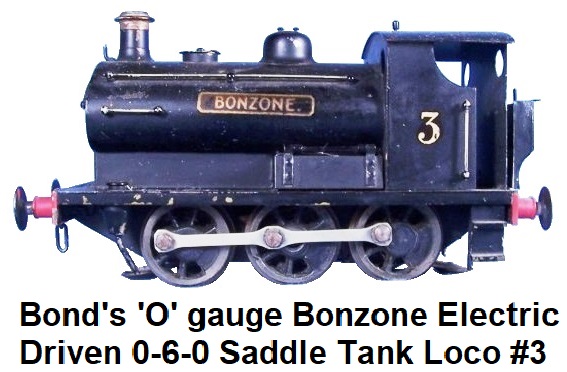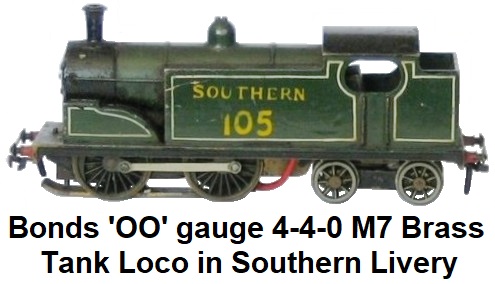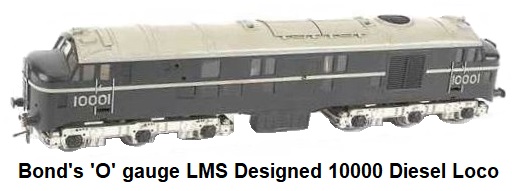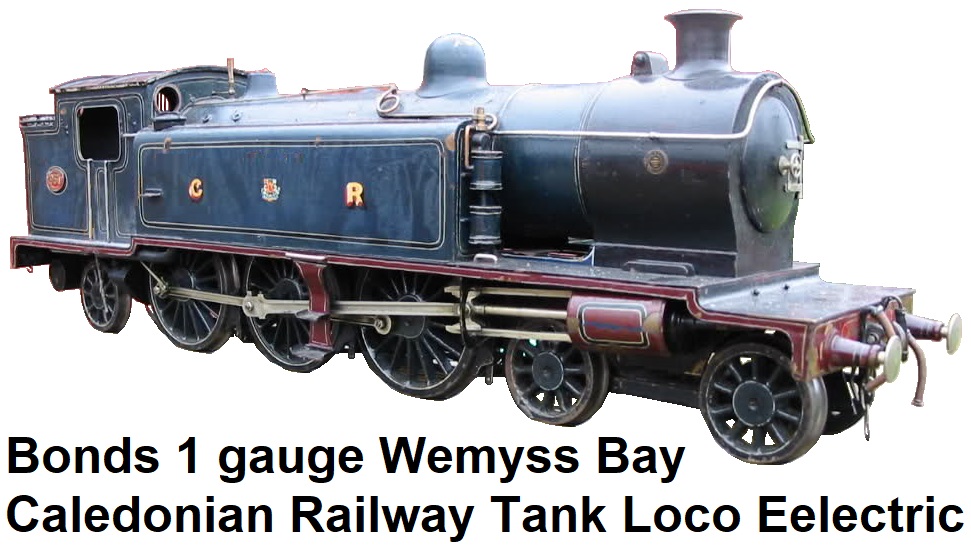 Bond's Ltd., London, UK was founded in 1887 as Arthur W. Bond. Bond's Ltd. was a model engineering and model supplies
company founded ten years before Bassett-Lowke Ltd.), and was also known as Bond's
of Euston Road, and the oddly-abbreviated Bond's O' Euston Road. The company changed its name in the early 1920's
after it moved to larger premises and to promote its new shop at 254 Euston
Road, London NW1, located on the north side of Euston Road between Hampstead Road and George
Street. The shop lasted until 1973, when the Euston Road area was redeveloped. As well as retailing other
company's products, Bond's also manufactured electric powered and steam powered locomotives and carriages in multiple
gauges/scales, and some well-regarded mechanisms and motors that often appeared in other manufacturers products as premium
options, with J. Fournerau acting as their agents in France. The firm was well known for the
publication of their "Bond's Model and Experimental Engineering Handbook". They sold, through their mail-order catalog, a
wide range of engineering and model-making accessories including a number of lighter lathes and horizontal milling machines
made for them by smaller independent machine-tool companies such as Sheffield firms of Portass and Adept.
Bond's Ltd., London, UK was founded in 1887 as Arthur W. Bond. Bond's Ltd. was a model engineering and model supplies
company founded ten years before Bassett-Lowke Ltd.), and was also known as Bond's
of Euston Road, and the oddly-abbreviated Bond's O' Euston Road. The company changed its name in the early 1920's
after it moved to larger premises and to promote its new shop at 254 Euston
Road, London NW1, located on the north side of Euston Road between Hampstead Road and George
Street. The shop lasted until 1973, when the Euston Road area was redeveloped. As well as retailing other
company's products, Bond's also manufactured electric powered and steam powered locomotives and carriages in multiple
gauges/scales, and some well-regarded mechanisms and motors that often appeared in other manufacturers products as premium
options, with J. Fournerau acting as their agents in France. The firm was well known for the
publication of their "Bond's Model and Experimental Engineering Handbook". They sold, through their mail-order catalog, a
wide range of engineering and model-making accessories including a number of lighter lathes and horizontal milling machines
made for them by smaller independent machine-tool companies such as Sheffield firms of Portass and Adept.
 Along with models of prototypical trains in several gauges, the shop sold a large selection of modelling supplies,
including tools, raw materials, miniature engines, kit-built yachts, and boats sourced from several other manufacturers.
They also had multi-gauge track for testing locomotives up to 7¼" gauge. Arthur Bond retired in 1929 but the company
continued its operation until 2010. In 1937 and 1938, their directors were
listed as S. D. Phillips and S. C. Phillips. Bond's prided themselves on stocking everything that would be of interest to
the model engineer whether they were interested in railways, ships, internal combustion engines or any other branch of
engineering from the smallest nut and bolt or rough materials, to some of the finest finished working models made at that
time by any model makers. In 1970 the company relocated to Midhurst, Sussex and changed their focus to selling general
do-it-yourself products and tools.
Along with models of prototypical trains in several gauges, the shop sold a large selection of modelling supplies,
including tools, raw materials, miniature engines, kit-built yachts, and boats sourced from several other manufacturers.
They also had multi-gauge track for testing locomotives up to 7¼" gauge. Arthur Bond retired in 1929 but the company
continued its operation until 2010. In 1937 and 1938, their directors were
listed as S. D. Phillips and S. C. Phillips. Bond's prided themselves on stocking everything that would be of interest to
the model engineer whether they were interested in railways, ships, internal combustion engines or any other branch of
engineering from the smallest nut and bolt or rough materials, to some of the finest finished working models made at that
time by any model makers. In 1970 the company relocated to Midhurst, Sussex and changed their focus to selling general
do-it-yourself products and tools.
Although the Bond's and Bassett-Lowke engineering product lines and catalogues seemed quite similar,
and Bond's had the head start, the company didn't have a charismatic globe-trotting founder like W.J. Bassett-Lowke,
sourcing foreign-made goods and building an empire of affiliated companies selling their wares under a single name.
Consequently, Bond's never became as big as B-L. However, Bond's managed to run their shop and mail-order
business without obvious mishap until the 1970's, when the shop was forced to close and relocate because of local
redevelopment in the central London neighborhood.

Bond's is chiefly remembered by model engineering enthusiasts who used to frequent the London shop as
part of their pilgrimage to an area packed with tool, electronics and engineering parts outlets, and by model railway
enthusiasts for their popular 'O' gauge Bonzone model locomotive, their Pullman carriages, and for a series of rather nice
exhibition-grade locomotive specials.
 Bond's sold the products and model locomotives of many other companies and manufacturers
including Bassett-Lowke, Leeds, Mills etc. They also produced their own range, including
track, wagons, coaches and their own home-produced locos, which are comparatively rare. A notable Bond's-produced
piece was the well-respected 'O' gauge Bonzone (Bond's Own) locomotive, a model of the Peckett saddle-tank industrial
locomotive used in collieries, quarries and docks. Advertising literature stated:
Bond's sold the products and model locomotives of many other companies and manufacturers
including Bassett-Lowke, Leeds, Mills etc. They also produced their own range, including
track, wagons, coaches and their own home-produced locos, which are comparatively rare. A notable Bond's-produced
piece was the well-respected 'O' gauge Bonzone (Bond's Own) locomotive, a model of the Peckett saddle-tank industrial
locomotive used in collieries, quarries and docks. Advertising literature stated:
" This scale model is Bond's own production, and follows true Peckett lines with semi-elliptical boiler and
correct type boiler mountings, steps, and buffers, etc., is fitted with a mechanism having the true type of iron driving
wheels, which are turned to a special profile, allowing this model to run on tinplate or true-scale tracks."
The 'Bonzone' was a nice addition to 'O' gauge enthusiasts' collections, as it was distinctively different to most of the
products from other manufacturers, it ran reliably, and its short wheelbase meant that it could cope with the curves of
almost any 'O' gauge layout.
 In the 1930's Bond's carried Bowman's line of stationary steam engines,
dynamos, lathes, speedboats, and live steam locomotives. This included the Bowman 0-4-0 Tank Loco in 2 sizes and the
Standard 4-4-0 Express loco. Scale model locomotives could also be built to order in any scale between 4mm and 1.5 inches
to the foot. Bond's produced a 3½" scale #6100 Royal Scot live steam loco in 1935 that was designed by Henry
Greenly. This detailed model featured a copper superheated boiler, nutted and soft-solder calked firebox, fed by axle
pump and auxiliary hand pump located in the tender, twin safety valves, 2 cylinders with piston valves actuated by a
Walschaerts valve gear, and a large displacement lubricator mounted behind the buffer beam with individual metering
valves for each cylinder.
In the 1930's Bond's carried Bowman's line of stationary steam engines,
dynamos, lathes, speedboats, and live steam locomotives. This included the Bowman 0-4-0 Tank Loco in 2 sizes and the
Standard 4-4-0 Express loco. Scale model locomotives could also be built to order in any scale between 4mm and 1.5 inches
to the foot. Bond's produced a 3½" scale #6100 Royal Scot live steam loco in 1935 that was designed by Henry
Greenly. This detailed model featured a copper superheated boiler, nutted and soft-solder calked firebox, fed by axle
pump and auxiliary hand pump located in the tender, twin safety valves, 2 cylinders with piston valves actuated by a
Walschaerts valve gear, and a large displacement lubricator mounted behind the buffer beam with individual metering
valves for each cylinder.
 Models have always played an important part in many famous films with a railway interest and
Bond's was instrumental in helping filmakers achieve realism on the screen with their models. One
custom commissioned model that was provided by Bond's was the LNER #4470 Great Northern, a Class A1 4-6-2 steam
locomotive built up to the scale of 1 inch to the foot and used in the making of a film at Elstree, mostly to provide
close-up and accident shots. The model had to be exactly correct so that errors would not be evident in the filming.
Also for the filming of 'Rome Express' a magnificent model of a PLM Pacific type locomotive was built by Bond’s O'Euston
Road Ltd., again to a scale of 1 inch to the foot.
Models have always played an important part in many famous films with a railway interest and
Bond's was instrumental in helping filmakers achieve realism on the screen with their models. One
custom commissioned model that was provided by Bond's was the LNER #4470 Great Northern, a Class A1 4-6-2 steam
locomotive built up to the scale of 1 inch to the foot and used in the making of a film at Elstree, mostly to provide
close-up and accident shots. The model had to be exactly correct so that errors would not be evident in the filming.
Also for the filming of 'Rome Express' a magnificent model of a PLM Pacific type locomotive was built by Bond’s O'Euston
Road Ltd., again to a scale of 1 inch to the foot.

In 1937 Bond's was commissioned to build a scale model of the Brighton Belle electric express in
tinplate. The Brighton Belle was a named train which was operated by the Southern Railway beginning in 1934 and
subsequently by British Rail, that ran from Victoria Station in London to Brighton, on the Sussex coast. The physical
superstructure of
the prototype model 5-car set was completed before the war, but with the outbreak of hostilities, the unfinished prototype
was put into storage. As a result of British government restrictions under the Miscellaneous Goods (Prohibition of
Manufacture and Supply) (No.4) Order (SR0966) Bond's could not sell any metal model or toy goods, complete or in parts,
or castings during World War II. It is beleived that once the prototype model was completed, the tooling
would be reused for a complete production run. Nothing certain is known of the model's history after World War II, until
it was discovered in John Procter's Brighton shop in the late 1960's, a place well-known for attracting rarities and
oddities. It is evident that after the War, the largely-completed, part-painted and probably only test-run set was sold
off, with someone at Bond's probably having decided to cut their losses and get rid of the set in its unfinished form.
The prototype was made from specially pre-formed and soldered parts, with the quality of workmanship and the constructional
design being exceptionally high, to the exhibition-grade standards that Bonds were known for on their more expensive
models. This 5-car set became the property of the Brighton Toy Museum where it was to undergo complete restoration to make
it a fully-finished, reliable, and smoothly-running exhibition-grade model. In later years, Bond's did issue 2-rail
fine scale electric Brighton Belle 5-car Pullman sets. These sets consisted of the Motor car #93, 3rd Class Trailing
dummy car #92, 3rd Class car #85, and 2 1st Class cars - Gwen and Mona, all painted in lined chocolate and cream with
interior details.
 Bond's created many passenger car models, including 'OO' gauge models. They are shown in the first editions of
the "Bond's Model and Experimental Engineering Handbook" (eg 1936/37), but can also be found in the edition of 1950.
Car's were available both in individual parts, as a kit and as ready-to-run. Bond's O'Euston Road also offered structures
including a terminus, a wayside station, and several rustic buildings to heighten scenic effect. The handbooks
issued by Bond's included hints, tips and advice to all their customers on how to start building a model railway, which
gauge to use, how to control points and wiring up electric track; with notes on running clockwork and electric locomotives;
and how to address all the signalling. They also wrote in very general terms about how the reader would approach building
a live steam model locomotive and how the components of such a locomotive are typically manufactured.
Bond's created many passenger car models, including 'OO' gauge models. They are shown in the first editions of
the "Bond's Model and Experimental Engineering Handbook" (eg 1936/37), but can also be found in the edition of 1950.
Car's were available both in individual parts, as a kit and as ready-to-run. Bond's O'Euston Road also offered structures
including a terminus, a wayside station, and several rustic buildings to heighten scenic effect. The handbooks
issued by Bond's included hints, tips and advice to all their customers on how to start building a model railway, which
gauge to use, how to control points and wiring up electric track; with notes on running clockwork and electric locomotives;
and how to address all the signalling. They also wrote in very general terms about how the reader would approach building
a live steam model locomotive and how the components of such a locomotive are typically manufactured.
 Bond's created a model of the LMS designed 10000 loco, of which two prototypes were built,
numbered 10000 and 10001. Both locos were introduced at the point of the nationalization of British railways in 1948.
The twin locomotives were the first diesels to be unleashed on the UK national railway
system, and were designed as prototypes for the LMS, with loco designer H.G. Ivatt in charge of overall design, and with
the new technological components designed and produced by English Electric. These locos proved their worth by hauling the
Euston-Glasgow express, including the notoriously difficult 'Shap Fell' incline. #10000 was withdrawn in 1963, and its
parts cannibalized to help maintain #10001, which kept going until 1966, and was then scrapped. The Bond's model was made
available in 1956 in 'O' gauge. It is beleived that only six of these models are known to have been built.
Bond's created a model of the LMS designed 10000 loco, of which two prototypes were built,
numbered 10000 and 10001. Both locos were introduced at the point of the nationalization of British railways in 1948.
The twin locomotives were the first diesels to be unleashed on the UK national railway
system, and were designed as prototypes for the LMS, with loco designer H.G. Ivatt in charge of overall design, and with
the new technological components designed and produced by English Electric. These locos proved their worth by hauling the
Euston-Glasgow express, including the notoriously difficult 'Shap Fell' incline. #10000 was withdrawn in 1963, and its
parts cannibalized to help maintain #10001, which kept going until 1966, and was then scrapped. The Bond's model was made
available in 1956 in 'O' gauge. It is beleived that only six of these models are known to have been built.
 Older model engineers in the UK will well remember the Bond's O’Euston Road shop. Quite probably they
bought their first set of castings there. After the shop moved out of London the shape of its business changed, although
it maintained a supply of model engineering items. After it closed down permanently in 2010, Alan Kiff bought up the
stock of model engineering items, including small bevel gears, worms and worm wheels, spiral gears, roller chain and
sprocket. Also a range of materials and tooling including steel, sliver steel, brass and copper, plus thread cut BA nuts
and bolts. Also some sizes of BA spanners, drills, tool bits, reamers, end mills, BA taps and dies, copper and
brass shim.
Older model engineers in the UK will well remember the Bond's O’Euston Road shop. Quite probably they
bought their first set of castings there. After the shop moved out of London the shape of its business changed, although
it maintained a supply of model engineering items. After it closed down permanently in 2010, Alan Kiff bought up the
stock of model engineering items, including small bevel gears, worms and worm wheels, spiral gears, roller chain and
sprocket. Also a range of materials and tooling including steel, sliver steel, brass and copper, plus thread cut BA nuts
and bolts. Also some sizes of BA spanners, drills, tool bits, reamers, end mills, BA taps and dies, copper and
brass shim.
 Comparatively few Bond's locomotives appear on the market, suggesting that production was relatively
small. Well constructed and maintained live steam locomotive models built from Bond's plans and parts have come
up at auction houses and garner prices in the $1000-$2500 and up range. The Bond's catalogues are of immense importance
partly due to their rarity, but also because they tell us today exactly what was available to the model engineer in a
given year. For example in the 1946 catalogue, Bond's sold specially drawn blue prints for the amateur to effect a model
of locomotives such as the L.M.S Mixed Traffic Loco #13245 Class in 'O' gauge; and drawings of 25-ton Goods Brake Vans,
again in 'O' gauge. There were even permanent way drawings to help model makers set up special railway layouts. Henry
Greenly Blue Print Drawings of Locomotives and J.E. Skinley drawings of railway locomotives and coaches were also on sale,
alongside heavier items such as flash steam boilers for racing speed boats and copper centre flue boat boilers.
Comparatively few Bond's locomotives appear on the market, suggesting that production was relatively
small. Well constructed and maintained live steam locomotive models built from Bond's plans and parts have come
up at auction houses and garner prices in the $1000-$2500 and up range. The Bond's catalogues are of immense importance
partly due to their rarity, but also because they tell us today exactly what was available to the model engineer in a
given year. For example in the 1946 catalogue, Bond's sold specially drawn blue prints for the amateur to effect a model
of locomotives such as the L.M.S Mixed Traffic Loco #13245 Class in 'O' gauge; and drawings of 25-ton Goods Brake Vans,
again in 'O' gauge. There were even permanent way drawings to help model makers set up special railway layouts. Henry
Greenly Blue Print Drawings of Locomotives and J.E. Skinley drawings of railway locomotives and coaches were also on sale,
alongside heavier items such as flash steam boilers for racing speed boats and copper centre flue boat boilers.
